1935 – 1946
During the first two decades of the 20th century, the Compagnie Générale Transatlantique (more commonly known as the French Line or CGT) had really established itself on the North Atlantic. The marvellous trio consisting of the France, Paris and De Grasse had earned the company a reputation of taking the very best of France to the high seas. Splendid interior designs, superb service and unparalleled cuisine were a few of the French Line’s hallmarks, making their vessels indeed something extra.
But although the distinguished French trio were fantastic ships, it was a ship that entered service in 1927 that would stand as one of the company’s all-time masterpieces – the Île de France. Where previous vessels had been decorated in styles of the past, the Île de France had been done in the new Art Deco. The appearance of the Île de France stunned the world, and for the first time in history, hotels began imitating a ship – instead of the other way around. This daring innovation was warmly embraced by the travelling public, and along with the other French Line characteristics, this undoubtedly made the Île de France a queen of the North Atlantic.
Noted primarily because of her interiors, the Île de France would never be remembered by her size or speed. In fact, it was evident that the Great War of 1914 – 1918 had halted the evolution of ocean liners. Before the war, the race for size and speed had resulted in giant vessels overtaking one another. But as the Thirties were approaching, these record holders were beginning to get old. The holder of the fabled Blue Riband was the ageing Cunarder Mauretania from 1907, and the world’s largest vessel was the White Star Line’s 56,551-ton Majestic, originally launched as the HAPAG liner Bismarck in 1914. But the ‘roaring Twenties’ had brought economic welfare, and the major shipping companies set out to break new records. Soon, the race would be on again.
Imperial Germany had lost nearly all of its merchant vessels when it was defeated in 1918. Ironically, it was a German pair of ships that would start the new era in shipping history. The Norddeutscher Lloyd’s Bremen entered service in 1929 and was followed by her sister Europa in 1930. At about 50,000 tons, these two ships could not challenge the Majestic’s size, but they had been built with speed in mind. Both ships were to become holders of the Blue Riband, the Bremen taking it from the Mauretania, who had held it for the last 22 years. Germany was back in the game.
Nevertheless, other nations had not been resting on their laurels. Both Cunard and White Star were planning new ships of both great speed and size. The French Line, by now a very worthy rival, did not want to be left behind. They wanted a supership of their own. So, the CGT approached the ever-reliable Penhoët shipyards at St. Nazaire. Many of the company’s previous vessels had been built here, among them the Île de France. Soon, engineers were pondering over figures and plans to succeed in their task – building the largest and fastest liner in the world. In famous CGT-tradition, it was also to become the most beautiful one so far.
With the success of the Île de France in mind, it was figured that a larger version of this ship would be a good idea. But a man at this point unknown to the French Line was to change these plans radically. Full of confidence in his potential, former Russian citizen Vladimir Yourkevitch approached the French Line with a suggestion to use a revolutionary hull-design. The design was developed completely by himself, and if it had not been for the fact that he once had designed four battle cruisers for the Russian Navy, it is likely that the CGT had politely but firmly asked him to go away. But with the aid of some friends in high places, Yourkevitch soon managed to make the French engineers listen to his ideas and suggestions. Actually, he had first turned to the Cunard Line with his offer, but the ever-conservative British had turned him down. They figured that the old, tested hull-type was the best for their new flagship.
Against all odds, the French engineers were actually impressed of what they heard and saw. From Yourkevitch’s specifications they constructed a model that was tested against their own hull-design. The result was astonishing. Yourkevitch’s design proved to be far more efficient than any hull-design constructed before. With the slanting clipper-like bow and the bulbous forefoot beneath the waterline in combination with the slim hull, this revolutionary design would create a hull with so far unprecedented hydrodynamic qualities, making almost no bow-wave and leaving only a thin, calm wake in its trail. It was obvious to the Penhoët-engineers that with this type of hull, their future vessel would not need as much horsepower as first calculated. But although having struck such a goldmine, there were still questions to be answered regarding the machinery of this new giant.
To compete with the British giants being built across the Channel, three figures had already been set for the new vessel: She would have to be some 80,000 tons, over 1,000 feet in length and she had to average a speed of 30 knots. To meet the latter requirement, the ship needed very powerful and fuel-efficient engines, and this presented a small problem for her makers. Ever since the Mauretania and Lusitania, all ocean greyhounds had relied on the steam turbine engine. But although powerful and economic, the turbine has a major flaw: It can only turn in one direction. To be able to go astern, a vessel fitted with turbines has to have auxiliary turbines installed to turn the propellers in the opposite direction. After much pondering over figures and plans, the French designers came up with a solution. The new vessel would be fitted with steam turbines, but these would not power the propellers but a set of electrical generators, which would power electric motors and these in their turn would power the screws. This solution produced a set of engines that would prove very successful. The problem of going astern was thus erased, as the electric motors could turn in both ways.
The plans for the new ship were pondered over again and again, and the construction was scheduled to commence soon. But on October 29th, 1929, The Great Crash of the stock markets occurred, and it would soon have a profound effect on the lives of the three 1,000-foot vessels being planned. At this stage, actual construction had begun on only one of the three, namely the White Star’s future Oceanic. In famous White Star tradition, she had been laid down in the shipyards of Harland & Wolff in Belfast. But the crash worsened White Star’s already strained financial situation, and the line was forced to cancel the order. There would never be a third Oceanic.
Fortunately for Cunard, or so they thought at least, their new ship had not yet been started on when The Great Crash came. Her keel was laid down in December 1930 in the yards of John Brown and Co., and Cunard aimed to get away with a cheaper ship if they could complete her before the economic situation recuperated, which it was soon expected to do. But time would prove them wrong. After only a year of construction, Cunard was forced to put the job on hold. The ship so far commonly known only as ‘Hull 534’ had an uncertain future ahead of her. Still hoping for better times though, the company decided not to break the unfinished ship up, but to keep on a minimal team of workers to maintain her. That way, maybe they could finish their vessel in the future. Fortunately this would be the case, but it took as long as two and a half years to achieve this goal, and it was only made possible through the merger with the company’s arch-rival White Star Line.
The French Line was more fortunate with their ship. In January 1931, work finally begun on the company’s new flagship. With France so far unaffected by The Great Crash, things looked a lot brighter than for the British. But the terrible economic situation in the world would not leave France untouched. As the Depression found its way into France, the CGT was forced to ask the French government for supporting subsidies. These were eventually granted, but only on the condition that the government was given the directorship of the company. Luckily, the company suffered no damage through this, since very capable men were put in charge. Still, there were for certain more than a few French citizens who questioned the necessity of investing great amounts of the French treasury on an ocean liner.
But work on the great ship continued, and she grew bigger and bigger as time went by. A well-covered topic in the media, the progress of her construction was followed with interest by the whole nation. As with the future Cunarder ‘Hull 534’, the French Leviathan had not yet been given a name. Her builders referred to her by her contract number – T6 – and the French press had already dubbed her ‘the super Île de France’. Many propositions of names surfaced during her construction, among others Maurice Chevalier, General Pershing, Pax Napoléon, Jeanne d’Arc, Neptune, Benjamin Franklin, Lindbergh, President Doumer and La Belle France. When the name Normandie was proposed, the Académie Française wanted either La Normandie or – more correctly since ships have a masculine gender in French – Le paquebot Normandie. To not confuse things, CGT decided upon simply Normandie.
And so, precisely three years after Black Thursday, on October 29th 1932, launch day arrived. Public interest in the new liner had not decreased, and the banks of the River Loire were filled with 200,000 eager spectators. The enormous hull awaiting its birth had an estimated weight of 27,657 tons – more than any other previous vessel. The French President Albert Lebrun was present, as was his wife who had been chosen to christen the new ship. As Mme Lebrun swung the world’s largest bottle of champagne (six quarts in all) across the bows, the Normandie came to life, bound to create headlines from the very start. As the hull slid down the slipways, which had been extended 328 feet underwater and greased with 43 tons of soap and 2 ½ tons of lard, she displaced thousands of tons of water, creating a huge wave. A hundred unfortunate spectators happened to stand in the way of this wave, which literally swept them all off their feet. Luckily, no one was seriously injured, and the Normandie could be moved to her fitting-out berth.
Originally, the Normandie had been scheduled to enter service in 1934, but transatlantic travel had declined due to the Depression, and so CGT decided to place their new flagship on hold until the spring of 1935. The workmen and designers who were busy making the Normandie the luxury liner she was supposed to be were given plenty of time to fulfil their task. Work continued as the Normandie grew more beautiful as time went by. Her exterior took shape as funnels and masts were installed, and within the massive hull, work went on to fill the empty spaces with carpets, panelling, artwork and furniture – all to create a true French masterpiece. CGT had once again called upon the services of some of the men who had been responsible for the interior designs on previous CGT-liners. Pierre Patout had become famous through his marble dining saloon on board the Île de France, and Richard Bouwens van der Boijen was the man behind the grand three-deck foyer on the same ship. Now, their mission was to surpass themselves.
And thanks to a special feature, they had all opportunity to do so. Adapted from the German pre-WWI liners Vaterland and Bismarck – now United States Lines’ Leviathan and White Star’s Majestic – the funnel uptakes of the Normandie had been split in two at the engine outtakes, and run up each side of the ship to rejoin at the bases of the funnels. This arrangement erased the problem of funnel uptakes occupying large amounts of the ship’s interiors, and created large empty areas for the designers to work with. But the results of their efforts were still to be revealed.
After more than two years of fitting out, on March 27th 1935, the Normandie was moved to dry dock to have her propellers installed and underwater parts examined and given a final paint job before the forthcoming maiden voyage. A little more than a month later, her sea trials commenced off the coast of Brittany. The world was eager to see this new superliner in action, and her sea trials were carefully followed by news reporters. They could report the fantastic hydrodynamic qualities of the Yourkevitch hull design, as the Normandie seemed to almost lack a bow wave, leaving only a thin wake in her trail.
Following a month of various trials at sea, the Normandie arrived at the port of Le Havre for the first time. 18 days later, she was scheduled to leave this port on her premiere crossing of the North Atlantic. These 18 days were now spent to put supplies on board and to give the ship a final touch-up. Everything had to be tip-top before the very first load of passengers could embark on the new pride of France.
Finally, the big day arrived. On May 29th, 50,000 people lined the docks to see the splendid Normandie set sail for New York on her maiden voyage. And what a wonderful sight she must have been! All about her breathed modernity. The clipper-like bow, the streamline-shaped superstructure and the three teardrop-shaped funnels – all aligned in perfect harmony and aesthetic perfection. And the forecastle was a masterpiece in itself. With very little gear visible behind the teak-coloured whaleback, the decks were clean and uncluttered. Moreover, this must be said about the rest of the decks as well. Every ventilator-shaft and every winch were cleverly concealed in the gleaming-white superstructure, leaving almost unlimited clean outdoor deck space for passenger-recreation. A large deck games area lay between the two first funnels, and between the second and the third (which was a dummy and housed the ship’s kennel), there was even a tennis deck. However, this amenity would seldom be used at sea, as winds could reach some 30 knots.
The dazzling design of the Normandie’s exterior was indeed something extra. But when venturing into her, I doubt that anyone could have been disappointed. Following the trend set by the Île de France nearly a decade earlier, the Normandie was a showcase of the very best that France had to offer, naturally done completely in fantastic Art Deco-style. Thanks to the split funnel uptakes, the Normandie’s interiors were matched by no other ship.
One of the most popular amenities was the café grill, located at the aftermost end of the promenade deck. From here led a grand staircase down to the first class smoking room, the staircase adorned by the statue ‘La Normandie’ depicting a French peasant girl. From the smoking room, one could continue further aft to the grand salon. This room would become one of the most popular ones on the ship, often transformed into a glamorous nightclub. Besides these grand public spaces, the Normandie broke new ground on many other amenities. For example, she was the first ship ever to carry a theatre on board, acting both as a cinema and live stage. The biggest in-door swimming pool could also be found onboard this new merchant flagship of France.
But the great masterpiece of the ship was not found among these rooms, but two decks below the promenade deck’s grand allée; The first class dining room. Without a peer on any other ship, this room was by far the largest one afloat. 305 feet (93 meters) long, 46 feet (14 meters) wide and 26 feet (8 meters) high, this room was truly a feast for the eye. With its 150 tables, it could seat 700 guests and offer them some of the finest meals ever served on board a ship. However, the split funnel uptakes running up the sides of the hull made it impossible for the room to have any windows to the open sea. Natural illumination was impossible, but instead of being a major flaw, this instead gave the Normandie one of her special features. Twelve tall pillars of Lalique glass illuminated the room and along the walls stood 38 columns equally bright. In addition, two chandeliers hung at each end of the room. It was this room that would earn the Normandie her nickname – ‘The Ship of Light’.
The Normandie was indeed a first class ship. This was evident when examining her passenger capacity. Although the largest ship in the world at 79,280 tons, she carried only 848 First Class passengers, 670 in Tourist Class and 454 in Third, a total of 1,972 people. These passengers were looked after by a crew of a total 1,339.
As the Normandie slipped her moorings and bid her country farewell, the French public was waiting to see if this was to be a record-breaking crossing. Although the Normandie had been constructed to maintain a service speed of 30 knots, the French Line had already proclaimed that they did not have their sights set for the Blue Riband. But as the maiden voyage of Normandie went on, it seemed an impossibility for her not to win the fabled award. On May 31st, it was announced that the Normandie had made a first day’s run of 744 nautical miles – a world record – by averaging a splendid 29.76 knots during the first 24 hours.
And so, as the Normandie arrived in New York after four days, three hours and fourteen minutes, she had crossed the North Atlantic with an average speed of 29.98 knots, faster than any liner before her. A marvellous success, she had wrestled the Blue Riband from the Italia Line’s Rex. As she made her way up the Hudson, towards the new West 50th Street terminal which had been lengthened by 200 feet, the Normandie flew a 30-foot Blue Riband pennant, one foot for each knot. Members of the crew were given a bronze medallion with the words ‘Blue Riband – Normandie’ printed on it. The fact that these medallions had been made in France prior to the maiden voyage is an indication that the French Line had been going for the Blue Riband all along, only not admitting it in fear of a possible failure.
However, no matter how successful the maiden voyage had been, it had revealed a few of the Normandie’s teething problems. As so many times before in shipping history, it had been found that the Normandie had a tendency to vibrate whilst going at high speed. These vibrations had been discovered during her sea trials, but the French Line officials had not seen them as a reason to delay the maiden voyage. However, during the crossing, many passengers living in Tourist Class cabins towards the stern had found them almost uninhabitable due to the shaking and rattling. They had been given other cabins, but CGT realised that the vibrations had to be remedied as soon as possible.
After a three-day turnaround in New York, with a dinner dance held on board the liner on June 4th, the Normandie left her pier for her first eastbound crossing on June 6th. Equally successful eastbound as westbound, the Normandie arrived at Southampton after four days, three hours and twenty-eight minutes. Her average speed had been 30.31 knots, and so she had beaten the eastbound record set by the Norddeutscher Lloyd-liner Bremen in 1929. The Normandie had met all expectations; she was indeed a complete success.
The Normandie spent the following summer and autumn serving her company very well, attracting a clientele of celebrities to grace her. But the problem of vibrations remained, and as winter arrived, the Normandie was brought in for some adjustments. After scientific studies of the situation, the stern part of the hull was strengthened and the original three-bladed screws were replaced by four-bladed ones. As the Normandie was ready to re-enter service, the vibrations were gone.
But the winter overhaul was also used to improve the Normandie for coming competition. During her first season, Cunard-White Star was busy finishing their own supership – ‘Hull 534’. It had been launched and christened Queen Mary in September 1935 and was scheduled to enter service in the summer of 1936. Moreover, it had been announced that the new Cunarder would become the first ship ever to exceed the 80,000-ton mark. At 79,280 gross tons, the Normandie would in that case lose the prestigious title of being the world’s largest liner to her British rival. Therefore, the French Line decided to increase the Normandie’s size, mainly through the addition of an enclosed tourist lounge on the aft boat deck. Following these and a few other alterations, the Normandie was re-measured as 83,423 gross tons. Exceeding the Queen Mary by some 2,000 tons, she would remain the world’s largest. But the question of speed still remained – would the Queen Mary be able to regain the Blue Riband for Britain?
Three months after the Normandie’s return on the North Atlantic, the Queen Mary set out on her maiden voyage. The British, with their very long and proud maritime traditions, were very confident in their new liner. Although she lacked the highly efficient hull design of the Normandie, she had been equipped with far more powerful engines. On July 1st 1936, the Queen Mary left Southampton for New York, with the Blue Riband in her sights. But due to foggy weather, she was not able to win the prize. Normandie was still the faster of the two, but it would not be long before the Queen made another go for it.
In August of 1936, the Queen Mary was able to beat the Normandie’s record. By averaging 30.14 knots on a westbound crossing, the Queen became the first ship to cross the Atlantic in less than four days. Soon, her engines had won her also the eastbound record. However, realising the free publicity available through this remarkable contest, the French Line had every intention to challenge the swift Queen once again.
The following season, in July of 1937, the Normandie pushed her engines further and managed to average 30.58 knots westbound and 31.20 knots eastbound. She had bettered the Queen Mary’s best performance and could once again fly the Blue Riband-pennant from her mainmast. She could match the Queen when it came to speed, but the great Cunarder held the upper hand when it came to another aspect – popularity. The grand and luxurious interiors of the Normandie were indeed beautiful, but seemed to almost frighten the regular traveller. She was a ship for the famous – film stars and royalties – and as a result she seldom sailed more than 60 percent full. The Queen Mary had been decorated in a more modest style. She was luxurious, but in a more comfortable way. The travelling public favoured the Queen, and she was booked nearly solid on almost all of her sailings.
Cunard-White Star was not satisfied with just having the more popular liner, though. Confident in the power of their magnificent Queen, they set out to once again win the Blue Riband from their French rivals. In August of 1938, she averaged 30.99 westbound and 31.69 eastbound, thereby leaving the Normandie behind once more. Earlier that year, in February, CGT had tried their flagship in a new role – cruising. With the poor business and relatively small amount of passengers on the North Atlantic, the French Line sent the Normandie on a gala cruise to Rio de Janeiro in search of a profitable auxiliary service during the off-season. With this journey, she became the largest ship ever to cross the equator.
The rivalry between the Normandie and Queen Mary may very well have continued into the Forties. In fact, when the Queen won the Blue Riband in 1938, the Normandie’s master sent a message in which he congratulated the British ship on her fine performance but ending it with the words ‘Bravo! to the Queen Mary until the next time.’ The two Leviathans were indeed true rivals, but the outbreak of World War II was to interrupt the competition.
On August 31st 1939, the Normandie was laid up at New York after having completed her 139th crossing, due to the impending threat of war in Europe. The following day these fears were justified when Adolf Hitler’s forces marched into Poland. By doing so, he made enemies out of Great Britain and her allies. The Second World War was ablaze. Normandie was moved to pier 88 and ‘mothballed’, maintained only by a skeleton crew of about 200 people. 60 special detectives and uniformed guards were on duty to guard the giant liner. Her rival, the Queen Mary, was moored beside her, on the south side of Cunard’s pier 90. The first winter of war in Europe came and went, and as German forces were successful on the battlefields, the Normandie lay idle, awaiting her uncertain future.
In March of 1940, a new great liner joined the Normandie and the Queen Mary in New York. She was the brand-new 83,673-ton Queen Elizabeth, who had just made her secret maiden voyage across the North Atlantic, in a daring escape from the threat of German bombers. For a brief period, the only three liners to exceed 80,000 gross tons were moored beside each other, the Queen Elizabeth on the north side of pier 90. The Queen Mary would soon sail to Sydney for her conversion into a troop transport.
In June of 1940, France surrendered to Nazi Germany. With this event, the Normandie was immediately taken into protective custody by the U.S. Coast guard, who introduced armed security patrols against sabotage. It was important to protect such a great ship, should she ever be needed for war duties.
Then, on December 7th 1941, Japanese forces attacked Pearl Harbor. United States, who up until now had stayed out of the war, now entered it on the side of Great Britain and her allies. Five days later, on December 12th, the Normandie was taken over (with compensation promised) by the U.S. Maritime Commission. Soon, the French tricolour was lowered and the Normandie was handed over to the U.S. Navy. On Christmas Eve, the Normandie was renamed Lafayette. But the name Normandie remained on her bows, thus she was never really acknowledged by the public as Lafayette. It had been decided that the Normandie was to be converted into a trooper, just like the two Queens, but there was no dry dock in New York large enough to accommodate her. Therefore, the conversion work was carried out where she lay, at pier 88.
Work went on, but amidst chaos. Thousands of workmen were employed with stripping the liner of her grand interior fittings, in preparation of her war duties as a trooper. On January 15th 1942, she was taken over by the War Department, and was scheduled to take on her first load of troops by the end of February. But still not completely converted, work went on at a frantic pace.
On February 9th, disaster struck. The Normandie was being victualled and stores were being loaded at the same time as conversion work went on. In the First Class Grand Salon, a team of workmen was busy cutting down metal stanchions that had once supported illuminated glass fountains. But due to careless work, a spark from one of the acetylene torches landed on a pile of kapok life jackets. With kapok being a highly flammable material, a fire was soon ablaze. It could easily have been extinguished, had it not been for the utterly negligent conditions. No firewatch was on duty, and no one could find the fire alarm (that at the time was disconnected anyway). Someone managed to produce a fire hose, but after having emptied a bucketful of water, it was completely dry. It took about twelve minutes before the New York Fire Department was alerted, and when they finally arrived at the scene they were not able to get on board the ship because of the great amount of workmen who were fleeing the blazing inferno. After an hour of chaos and turmoil, the firefighters were at last able to board the burning Normandie and start their difficult task of controlling the fire.
Soon, water was desperately being pumped over the burning liner in an attempt to fight the raging blaze. Fire trucks stood on the pier, and fire boats had gathered on the Normandie’s port side to help. Unfortunately, as they poured water onto the French liner she began to take on a dangerous list to port. The ship’s compartmentation kept the water from entering the lower decks, resulting in her becoming top heavy. Vladimir Yourkevitch, who had designed her, arrived at the scene and offered to go on board the ship and open the seacocks, him being the man who knew most about her maze of corridors and passageways. By doing so, the Normandie would have settled on an even keel in the mud, rescuing her from heeling over. But the navy commander at the scene did not want Yourkevitch’s help – ‘This is a navy job!’ he said.
And so, as night fell on Normandie, she was leaning farther and farther away from the pier. The fire had been brought under control, but at a terrible cost. At about 2.45 a.m., on the morning of February 10th, the Normandie slid almost gently onto her port side at an angle of 79°; her stern slid under the pier and her bow slewed across the berth towards pier 90. She seemed a total loss, but there were people who had good hopes of salvaging her and turning her into a trooper.
Twelve days after the disastrous fire, the difficult salvage work began. It had been decided that each of the Normandie’s sub-compartments would be sealed and pumped clear to regain the ship’s buoyancy. However, this meant that the ship’s funnels, masts and superstructure had to be cut away. Floating derricks were stationed beside the giant liner, and work began on cutting up the massive funnels. Divers were sent into the submerged port compartments to seal every opening.
Final pumping commenced on August 4th 1943, one and a half years since the fire. As the hull started to lift from the muddy bottom of the Hudson, jets of water were directed under it to reduce the suction of the silt. Other pumps removed the silt which settled within the hull as it moved. When the hull had been righted to an angle of 45°, it was moved to the centre of the slip between piers 88 and 90 for the final righting process; the final phase of the salvage could begin. This involved water from the port tanks being pumped over to the starboard tanks to bring the ship back on an even keel. And finally, on October 27th 1943, the Normandie was back on an even keel and was handed over to the U.S. Navy.
But the great ship was no longer needed for the war effort. She was in worse condition than expected, and no one really knew what to do with her. On November 3rd, with a 2° list, the once so proud and sleek Normandie was towed down the Hudson to the Brooklyn Navy Yard’s Erie Basin where she would await her ultimate fate. A number of suggestions were made. Some wanted to convert the Normandie into an aircraft carrier, but this scheme was abandoned due to too high costs – it was cheaper to build new ones. President Roosevelt asked William Francis Gibbs, one of the country’s greatest naval architects, to investigate the possibilities of rebuilding the Normandie as a passenger liner after the war. Plans were discussed and costs were calculated, but in the end it was decided to sell the Normandie for scrap.
In October 1946, the Normandie was sold to Lipsett Inc. for a mere $160,000, and she was towed by twelve tugs to Port Newark. Here, work on cutting her up soon began. One year later, the final pieces of steel had been sent to the steel mills. The Normandie was gone, after a very sad and inappropriate end. Through her short life, she had seen only four years of commercial service. I am confident that many ocean liner buffs agree with me to the full when I say that in some aspects, the Normandie was the greatest ocean liner of all.
Specifications
- 1,028 feet (314 m) long
- 117 feet (35.7 m) wide
- Originally 79,280 gross tons, increased to 83,423 gross tons during 1935-1936 overhaul
- Steam turbo-electric engines turning four propellers
- 29 knot service speed
- Passenger capacity of 1,972 people

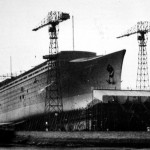
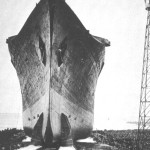
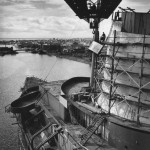
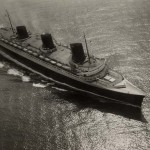
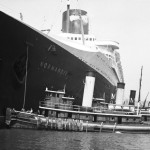
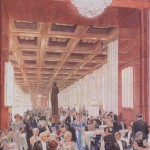
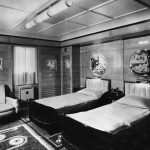
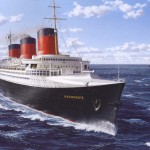
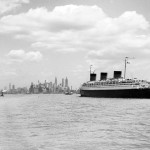
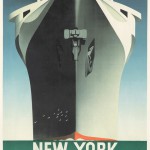
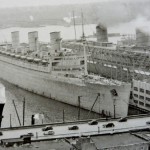
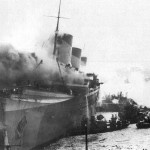
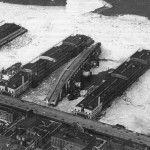
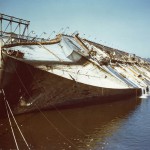
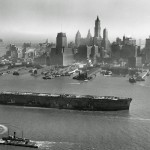
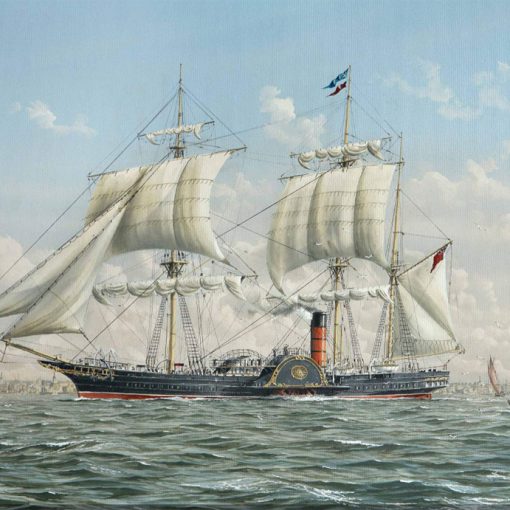
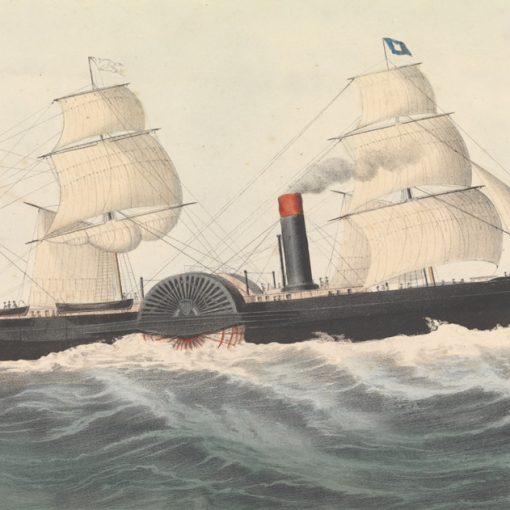
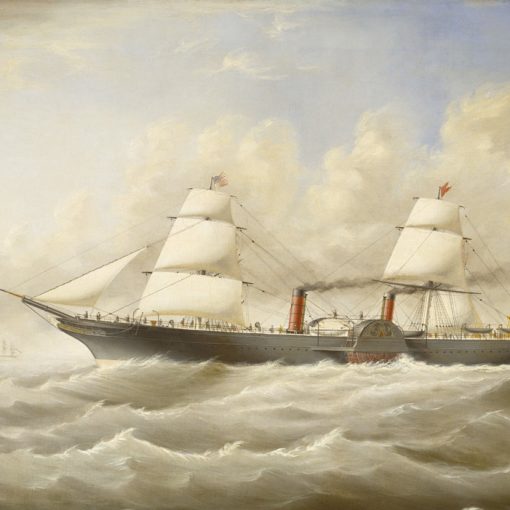
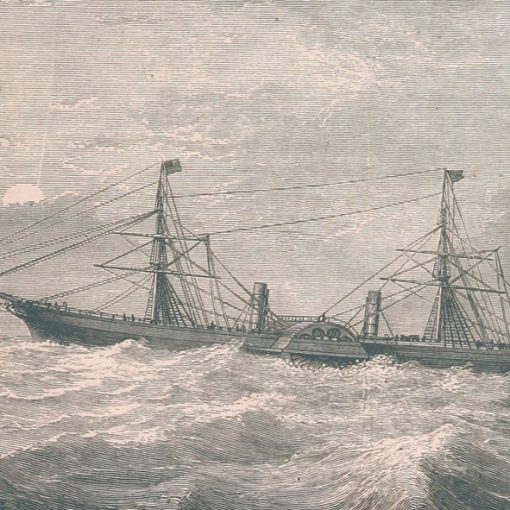
One thought on “Normandie (II)”
I have the original negatives (4×5’s) of the dimanteling of the normandy in port Newar, NJ if you are interested – Very High Quality Images. – I own the rights.